A Paipo
Interview with Reinaldo “Dragão” Andraus
October 14, 2013 - São Paulo City, Brazil
E-mail interview by Bob Green
Reinaldo began his surfing life at the beach breaks of
Santos, the local beach of São Paulo. First bodysurfing, known
as "pegar jacaré" (surf a wave with you body stretched as long
as you can - like an alligator), Reinaldo then rode a wooden board
followed by a coolite, before getting a surfboard. In addition to
riding waves, Reinaldo has been documenting the history of Brazilian
surfing. His impressive book is still a work in progress.
|
1. How did
you first become interested in riding waves?
I lived my whole life in São Paulo City,
100 kms from the sea. My parents always had an apartment by the beach.
It was a natural thing. The main diversion was the sea. I can define
two different moments in my life. As a boy when I was six to seven
years my dad taught me to body surf, then (I don't know the exact year)
I started using this board (mini alaia). THEN, in 1967, I saw the film Endless Summer in the movie circuit. That changed my life. From then on
(I was 10) I started my campaign to get a surfboard. It happened during the
Easter of 1969, when 12 years of age. My surfboard was a Glaspac MK3
molded series almost 10 feet long. Heavy, I couldn't carry it alone. I
started to surf standing-up then. Never stopped |
|
Reinaldo “Dragão” Andraus with boards he first
rode in the 1960s. Photo by Silvia Winik.
|
2. You've mentioned riding a jacaré board in the
1960s. When and where was this? For how many years did you ride a
jacaré board?
First we had an apartment in Santos, with small
rolling waves. My first board was the wood mini-alaia. I rode this board for
some five years, from the mid-1960s on… In 1967, my parents
moved to Guarujá, the waves there are way bigger. In 1967, the
evolution for my body boarding was the acquisition of a Styrofoam
(Isopor) board, called planonda. Even with this more buoyant craft I
still liked the feel of the wood board and used both of them depending
on my mood. The alaia broke (from nose to tail) and I discarded it. My planonda is in the Museu do Surf
(Surfing Museum) in Santos [see a list of surf museums in Brazil in Note 1]. Basically
I bodyboarded from 1963/1964 to 1969. I left them both aside after
getting my
first surfboard.
Reinaldo with longboard,
planonda and jacaré.

Photo by Silvia Winik
Can you explain what the phrase "pegar jacaré"
means? What did you call going surfing on these boards?
"Pegar jacaré" means in Portuguese, the act of surfing waves.
Because your body in the water looked like an alligator... In my
opinion "pegar" = "get" and "jacaré" = "alligator" or, to
surf a wave with your body stretched as long as you can.
"Board" is "prancha" and "surfing" is "surfar." I usually referred to
"pegar jacaré" if I went body surfing and "surfar de
prancha" if I were using my little alaia wood board.
The bodyboards in the beginning were called prancha de madeira (wood)
and the planonda prancha de isopor (styrofoam), Then came the boogie boards created by Tom Morey.
3. Do you recall where you acquired the board? Was it
bought from a shop or homemade?
Both of the boards were bought in stores that sold
balls, mats, umbrellas, chairs for the beach… You went to beach
stores and there was a stock of 10 or 20 boards for sale. In São
Paulo, I never saw any color in the wood boards. The planonda came with
colors and drawings. My original planonda didn't have any drawing -
just the word planonda written in blue.
4. What can you tell me about the dimensions and design of the board? Was this typical of this style of board?
Yes,
they could be easily found in beach
stores. The boards were about 36 x 12 x 1/2 inches with rocker in the
nose area. They had two "handles" on the edges. These
handles were only to carry [the board] as I never used them surfing,
maybe just to hold the board in the shorebreak.
(Left) Jacaré
board showing lift. (Right) Handgrip closeup.
|

|
|

|
Photos by Sylvia Winik.
5. Were these boards mainly used in shallow water to
ride white water, or closeouts, or could you catch and ride unbroken
waves further out?
You could ride them everywhere. I went outside
and never used swim fins. Catching unbroken waves was the real thrill.
With the planonda (and it's added buoyancy), I went further and further
OUT in bigger days.
Most of the kids rode them in white water, standing on the sand to get
propulsion. Standing in waist high water you pushed with your feet to
get initial speed and surfed the wave in shallow water. We used that
technique to propel the board instead of kicking the feet (which was
done afterwards).
6. Was there much technique involved in riding one of
these boards?
No, just fun. You watched what your friends did
and tried to match. Usually the goal was to ride the wave all the way
until the board "landed" on dry sand.
7. Did many people ride these boards? Where would you
see them ridden and who mainly rode these boards?
Not many, but I had a bunch of friends in
Pitangueiras Beach, right in front of my building. But I think they
were used all over Brazil. The boards were mass produced beach toys. With stand-up surfing we started exploring our coastline.
Reinaldo at
Astúrias Beach, Brazil. The design on the deck of the board was
a lion in a shield copied from the Encyclopedia Britannica. This is
where Reinaldo's nickname, "Dragon," (Dragão) comes from.

Photo courtesy of Reinaldo
Andraus.
8. What do you know about the history of these boards?
Was there much evolution of the design?
I
never thought about that until I had my
surfboard. What I saw was what I got. I just wanted to go surfing. The
product available in the shop was the toy. That was the same with my
first surfboard, as there were very few manufacturers at the time
(late-1960s). Bear in mind, I was 10, 11, 12... I only got interested
in
design and serious performance after I was 15 years old. That was
around my third
or fourth surfboard.
(Below left) Reinaldo with
Alcino Pirata (Pirata is pirate in English, a nickname because of his
artificial leg which initially was made of wood). (Below right) Reinaldo with museum boards similar to the boards Reinaldo first
surfed on.
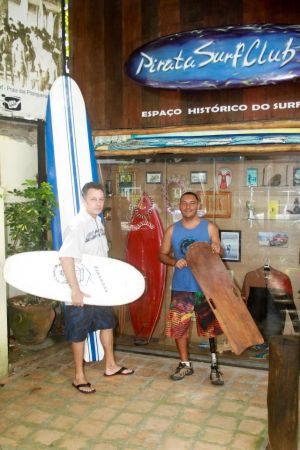 |
|
Alcino Pirata's surf school
is in Pitangueiras Beach, right in front of the Pirata Surf Club (surf
shop/museum/surf school) at Guarujá in São Paulo state.
Reinaldo has advised that Alcino's leg was amputated as a result of a
motorbike accident. He kept surfing and has surfed 6' Padang Padang.
Alcino's photo has appeared in Surfing Life (formerly Australia's Surfing
Life), tubed, standing on one leg and balanced by one hand on the deck.
|
Photo by Silvia Winik and
caption information by Reinaldo.
9. Over what time period were these boards used? Why did
their use decline?
Today they are not produced anymore. But I
remember seeing people using these small alaias even during the 1980s.
The Isopor boards are the introduction to most kids even today, then
they buy the more expensive Morey Boogies. Then, if it get
serious, surfboards. What made the decline was the mass production of
(inexpensive) boogie boards, flooding the market.
10. Irencyr Beltrão has spoken of
the church door style of board. What were these boards like and over
what time period were they used? [See Note 2.]
I never saw a church door style board in São Paulo --
they were used in Rio (400 kms north). They were left aside when the madeirite boards came along, around 1959. Madeirites were the evolution used
in Brazil in the early sixties until 1964, before the first foam boards
started to arrive and be produced here. Madeirites were "the norm"
surfboards here in the early-1960's. Wood in Portuguese is madeira,
that's where the name came from.
11. Photos of madeirites show surfers wearing swim fins.
Can you explain what a madeirite board was and whether they were always
ridden standing-up? It must have been difficult standing on a low
buoyancy board wearing flippers. Was there a special technique involved
or were the flippers modified for standing up?
Well, I never experienced that, as I went from
my planonda to a fiberglass surfboard. I heard they cut the front part
of the swim fins so they could stand up without tripping. The madeirite
was a Brazilian phenomenon and were built for stand-up surfing. But I'm
sure people went prone on them. After the beginning with the
"inventors" - Irencyir and friends, the madeirite also went on to be
sold in sports stores.
12. Was there a history of indigenous people riding
waves in Brazil?
I never heard about that, but It's reasonable
to speculate.
(See more information in Note 3.)
13. What started your interest in surfing history? Can
you tell me about your book project?
As I started working as editor of surfing
magazines in Brazil, my passion for the sport evolved to seek a broad
knowledge of it. Once I was giving a lecture on the History of Surfing
in University of São Paulo and the students asked for a
bibliography and that triggered the idea, as there were only magazines
about the subject. I was already thinking about writing a surf book.
The format História do
Surf Brasileiro came to my mind. My research for this project is
only starting...
Draft Book cover of A Grand History of Brazilian Surfing (A Grande História do Surf Brasileiro).
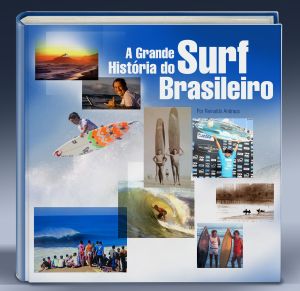
Photo courtesy of Reinaldo Andraus.
14. Where has your surfing journey taken you. What
boards do you ride and any final thoughts?
Surfing is a journey of its own. Being in the
ocean, riding waves, no matter which instrument you use, is an
exhilarating experience. Today I surf mostly with longboards, as I'm
heavier and reaching my sixties. But I love watching the ASP webcasts.
The evolution of surfing is incredible in all aspects. BUT we have to
go further… Never forgetting about the past and the roots. The
history and legacy of this sport of kings, the lifestyle, this art
form, religion, spiritual quest… Surfing is a fulfilling
experience. Being in the ocean for long periods of time is one of the
healthiest things that a human being can do. We are lucky! Keep playing
in the sea water.
|
Note 1. There are several surf museums in Brazil, including
-
Museu Do Surf Cabo Frio. Located in Cabo Frio, 200 kms north of Rio de Janeiro. Website link.
- Museu Do Surf Santos. Located in Santos, 70 kms east of São Paulo city. Santos museums website link and Trip Advisor web link.
- Museu Do Surf Rico. Located in Rio de Janeiro city and operated by legendary surfer Rico De Souza. Website link.
- Pirata Surf Club. In Guarujá, in the São Paulo area, on a smaller scale but can be considered a museum. Website link and Facebook link.
Note 2: Irencyr Beltrão noted in the waves.terra website,
"These guys started surfing
with boards known at the time (1950s) as "church door." Then came the
"madeirites" and, finally, the fiberglass boards.
"Esta galera começou surfando com pranchas conhecidas na
época (anos 1950) como "porta de igreja." Depois, vieram as
"madeirites" e, finalmente, as pranchas de fibra de vidro."
Irencyr Beltrão identified these surfers as
acquaintances with madeirites he designed in the 1960s.
Irencyr Beltrão, "Sao todos meus
conhecidos e estas madeirites foram projetadas por mim e construidas na
Ilha do Governdor pelo Moacir. Nao foram dos anos 50 e sim anos 60 e
tal."

Unknown author. (1964, January 18). A nova ordem é de pé sôbre as ondas. O Cruzeiro, 36(15), 92-97.
Note 3: In Peru, riding waves had a history predating the Spanish
conquistadors.
Pre-Columbian
Peruvian surfing images: Nazca and Chimu figures.
|
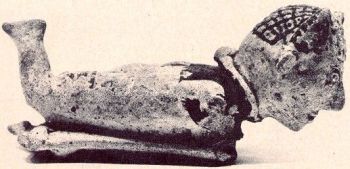
|
|

|
Geoff Cater's surfresearch.com.au site
identified the source of the image as Graciela Laffi's private museum
with the photo taken by Jose Antonio "Gringo" De LavalIe; Museo
Regional Arqueológico Enrique Bruning de Lambayeque, Peru.
(Below left) Thor Heyerdahl
with Peruvian children holding traditional reed craft, still ridden
around Huanchaco and surrounding coastal areas. (Below right) Mural section from the
Chiclayo area.
|
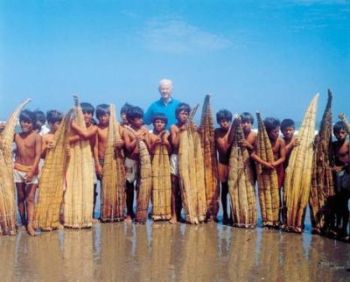
|
|
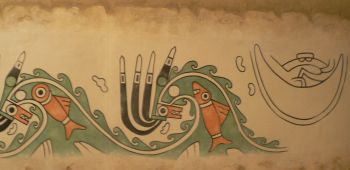
|
(Above right) T.
Heyerdahl (2000). Scandinavian Ancestry. Azerbaijan International, 8.2,
at:
http://azeri.org/Azeri/az_latin/latin_articles/latin_text/latin_82/eng_82/82_heyerdahl.html;
(Above right) Museo Regional Arqueológico Enrique Bruning de
Lambayeque, Peru. |
|